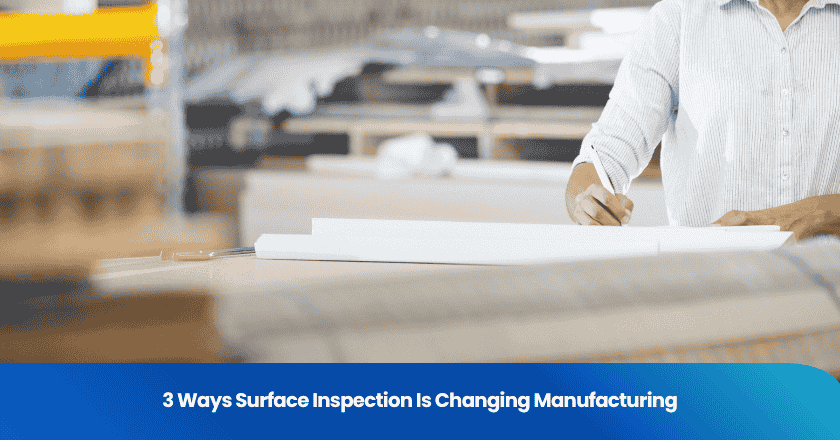
You see surface inspection with machine vision driving remarkable shifts in manufacturing.The Surface Vision & Inspection Market is projected to reach over USD 8.3 billion by 2032, fueled by the demand for stricter quality assurance and inspection.Manufacturers using AI-powered visual inspection report up to 50% fewer defects and a 30% boost in productivity.These advances let you achieve higher quality, faster output, and better-informed decisions on the production floor.
Key Takeaways
- Surface inspection with machine vision can reduce defect rates by up to 50%, ensuring higher product quality.
- Automated inspection systems operate at remarkable speeds, inspecting products in milliseconds and boosting productivity by around 30%.
- Real-time feedback from vision systems allows for immediate corrective actions, minimizing waste and preventing defective products from reaching customers.
- Integrating machine vision systems enhances consistency in quality control, eliminating human error and ensuring reliable defect detection.
- Data collected from inspection systems supports continuous improvement, helping manufacturers identify trends and optimize processes.
Surface Inspection and Quality Control
Defect Detection Accuracy
You can achieve a new level of precision in quality control by using surface inspection machine vision systems. These systems rely on high-resolution cameras and advanced image processing to examine every product for even the smallest defect. Unlike manual inspection, which often misses subtle flaws, vision systems detect micron-scale deviations and ensure strict adherence to quality standards. For example, you can identify cracks, discolorations, and structural deviations that might otherwise escape notice. Automated inspection systems allow you to verify dimensional accuracy, assess solder quality, and evaluate surface finish consistency—all at speeds that keep up with your production line.
Machine vision systems standardize the inspection process, eliminating subjectivity and variation. You benefit from consistent, reliable defect detection across every shift.
| Metric | Traditional Methods | AI-Driven Systems |
|---|---|---|
| Accuracy | 85-90% | 99.5%+ |
| Speed | 2-3 seconds/unit | 0.2 seconds/unit |
Reducing Human Error
When you rely on vision systems, you remove the risk of fatigue and oversight that comes with manual inspection. Human inspectors may overlook defects after hours on the line, but automated inspection delivers the same high level of performance every time. Integrating machine vision systems into your workflow means you can trust the results, knowing that every product meets your quality control benchmarks. Industrial cameras and defect detection automation ensure that you catch misalignments, material inconsistencies, and surface scratches before they reach your customers.
| Feature/Benefit | Machine Vision Systems | Human Inspectors |
|---|---|---|
| Consistency | High, no subjectivity | Variable, prone to error |
| Detection Capability | Micron-scale | Limited |
| Real-time Feedback | Yes | No |
Real-Time Detection
Surface inspection with vision systems gives you real-time feedback on your production line. Automated inspection operates continuously, allowing you to catch defects as soon as they appear. This rapid detection reduces waste and prevents defective products from moving further down the line. You can monitor for surface flaws, packaging integrity, and fill levels instantly. Real-time monitoring also supports regulatory compliance by capturing detailed inspection data for every batch.
- Increases accuracy in defect detection
- Reduces inspection time from 1 minute to 2.2 seconds
- Lowers defect rates by up to 30%
- Enables immediate corrective actions
By adopting surface inspection powered by machine vision, you ensure that your product quality remains high, your processes stay efficient, and your customers receive only the best.
Machine Vision for Production Efficiency
Automated Inspection Speed
You can transform your production line by integrating machine vision systems for surface inspection. These systems automate the inspection process, using high-resolution cameras and advanced image processing to scan products at remarkable speeds. Automated inspection systems perform multiple inspections per second, allowing you to process hundreds of units each minute. This rapid defect detection eliminates bottlenecks and keeps your workflow moving. In one example, automated optical inspection reduced cycle time by 20%, showing a clear advantage over manual inspection. You achieve consistent quality control and maintain high product quality, even as production volume increases.
- Machine vision setups reduce processing time to milliseconds per board.
- Real-time defect detection automation enables immediate reactions to issues.
- Automated inspection ensures every product meets your quality control standards.
Minimizing Downtime
Vision systems play a crucial role in minimizing downtime. Continuous real-time monitoring of defects and equipment allows you to identify problems early and prevent costly production delays. Machine vision-based surface inspection systems operate at high speeds, providing instant feedback and supporting uninterrupted production flow. You can address defects as soon as they appear, reducing the risk of extended stoppages. This approach not only maintains product quality but also boosts overall efficiency.
Real-time defect identification means you spend less time troubleshooting and more time producing.
| Contribution | Description |
|---|---|
| Real-time monitoring | Immediate detection and addressing of defects, minimizing downtime. |
| High efficiency | Processing thousands of components per minute without sacrificing quality. |
| Cost savings | Minimizing waste and improving yield for better profitability. |
Resource Optimization
You optimize resources by leveraging machine vision for surface inspection. Automated data collection provides insights into equipment utilization and highlights areas for improvement. Machine vision systems deliver significant cost savings by reducing labor needs and minimizing errors that lead to waste. Early defect detection prevents defective materials from advancing, which reduces material waste and supports sustainable practices. Integrating machine vision systems ensures that you use materials efficiently and maintain high product quality.
- AI detects inconsistencies early, preventing recalls and reducing waste.
- Automated inspection and defect detection improve energy efficiency and lower utility costs.
- You gain a strong return on investment by optimizing labor and material resources.
By adopting surface inspection machine vision systems, you streamline your operations, maximize throughput, and maintain continuous quality control. This technology empowers you to achieve higher efficiency, lower costs, and superior product quality.
Data-Driven Process Improvement
Inspection Data Analysis
You gain a powerful advantage when you use surface inspection machine vision systems to collect and analyze inspection data. Vision systems equipped with high-resolution cameras and artificial intelligence capture every detail of your production process. Automated inspection generates a steady stream of data, which you can use to monitor defect detection and product quality in real time. By cataloging patterns in defects and marking incorrect variables, you quickly identify the root causes of issues. This approach supports improved product consistency and helps you maintain strict quality control standards.
| Analytical Method | Description |
|---|---|
| Statistical Process Control (SPC) | Monitors real-time production data to identify unusual variations. |
| Root Cause Analysis (RCA) | Finds the source of recurring defects and applies corrective actions. |
| Failure Mode and Effects Analysis (FMEA) | Anticipates potential failure points before they happen. |
Vision systems also track the frequency of defects, allowing you to spot trends and address them before they impact product quality.
Trend Detection
With machine vision, you can detect trends that would be impossible to see with manual inspection. Vision systems use defect detection automation and AI integration to analyze operational data, revealing recurring defect types and their frequency. You compare defect rates across different production lines and use this information to optimize your processes. Real-time feedback from automated inspection helps you respond to issues immediately, reducing waste and improving efficiency.
- Defect trend analysis monitors recurring defect types.
- Production line comparison identifies variations in defect rates.
- Machine/process feedback loops optimize processes and reduce defects.
Real-time quality analytics from vision systems lead to improved product consistency and lower scrap rates.
Continuous Improvement
You drive continuous improvement by leveraging the insights gained from vision systems. Inspection data supports predictive analytics, which helps you anticipate quality issues and prevent future defects. Metrics such as accuracy, precision, recall, and execution time measure the effectiveness of your detection systems. You use these metrics to fine-tune your processes and maintain high product quality.
| Metric | Description |
|---|---|
| Accuracy | Reflects the system’s overall success rate in identifying objects or patterns correctly. |
| Precision | Measures how often the system’s positive predictions are correct. |
| Recall | Assesses the system’s ability to detect all relevant instances. |
| Execution Time | Evaluates how quickly the system processes images and identifies workpieces. |
By adopting machine vision and automated inspection, you ensure robust defect identification, maintain high standards of quality control, and achieve ongoing process optimization. This data-driven approach empowers you to deliver superior product quality and stay competitive in the manufacturing industry.
You now see how surface inspection with machine vision transforms manufacturing by improving quality control, boosting efficiency, and enabling smarter process improvement. These systems deliver higher accuracy, faster inspection, and real-time analytics, helping you meet strict standards and reduce costs.
- Enhanced precision and speed drive better product quality.
- Automation reduces labor costs and increases throughput.
- Real-time data supports continuous improvement.
Experts recommend prioritizing 3D and AI technologies for applications needing micron-level accuracy.
| Resource Type | Description |
|---|---|
| Technical Documentation | Guides on implementing machine vision for quality control and defect detection. |
| Case Studies | Real-world examples of automated inspection in manufacturing. |
| Webinars | Educational sessions on the latest surface inspection technologies. |
Explore these resources to learn how vision systems can elevate your operations and secure a competitive edge.
FAQ
What types of defects can machine vision surface inspection detect?
You can identify cracks, scratches, discolorations, dents, and dimensional errors. Machine vision systems also spot surface contamination and misalignments.
These systems catch both visible and subtle flaws that manual inspection may miss.
How does automated surface inspection improve production speed?
Automated systems inspect products in milliseconds.
- You process more units per minute
- You reduce bottlenecks
- You maintain consistent quality
Is it difficult to integrate machine vision into existing production lines?
You can integrate most machine vision systems with minimal disruption.
Many solutions offer modular designs and flexible software, making setup straightforward for your team.
What data can you collect from surface inspection systems?
You collect defect rates, inspection times, and trend data.
Grow your business with TradeAider Service
Click the button below to directly enter the TradeAider Service System. The simple steps from booking and payment to receiving reports are easy to operate.


